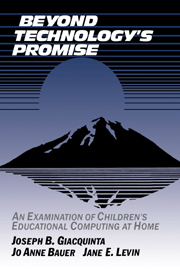Book contents
- Frontmatter
- Contents
- List of Tables and Figures
- Preface
- Chapter 1 THE PROMISE
- Chapter 2 STUDYING THE PROMISE
- Chapter 3 THE ABSENCE OF CHILDREN'S ACADEMIC COMPUTING AT HOME
- Chapter 4 THE AVAILABILITY OF EDUCATIONAL SOFTWARE
- Chapter 5 THE IMPORTANCE OF PARENTAL ENCOURAGEMENT AND ASSISTANCE
- Chapter 6 THE ROLE OF GENDER IN HOME COMPUTER USE
- Chapter 7 SCHOOL USE OF COMPUTERS
- Chapter 8 CHILDREN'S PREFERENCE FOR GAMES
- Chapter 9 REDEFINING A NEW TECHNOLOGY AS A SOCIAL INNOVATION
- Chapter 10 VIEWING TECHNOLOGICAL CHANGE AS A SOCIAL PROCESS
- Chapter 11 REEXAMINING THE HOME-SCHOOL COMPUTER CONNECTION
- Chapter 12 WHERE DO WE GO FROM HERE?
- Appendix A A FURTHER NOTE ON SITE FIELDWORK AND ANALYSIS
- Appendix B LIST OF CODES FOR SITE LOG ANALYSIS
- Appendix C SITE LOG ANALYSIS CODEBOOK
- Appendix D LIST OF FAMILIES AND SCHOOL-AGED CHILDREN
- Appendix E SPECIFIC STEPS FAMILIES MIGHT TAKE
- References
- Index
Chapter 8 - CHILDREN'S PREFERENCE FOR GAMES
Published online by Cambridge University Press: 05 March 2012
- Frontmatter
- Contents
- List of Tables and Figures
- Preface
- Chapter 1 THE PROMISE
- Chapter 2 STUDYING THE PROMISE
- Chapter 3 THE ABSENCE OF CHILDREN'S ACADEMIC COMPUTING AT HOME
- Chapter 4 THE AVAILABILITY OF EDUCATIONAL SOFTWARE
- Chapter 5 THE IMPORTANCE OF PARENTAL ENCOURAGEMENT AND ASSISTANCE
- Chapter 6 THE ROLE OF GENDER IN HOME COMPUTER USE
- Chapter 7 SCHOOL USE OF COMPUTERS
- Chapter 8 CHILDREN'S PREFERENCE FOR GAMES
- Chapter 9 REDEFINING A NEW TECHNOLOGY AS A SOCIAL INNOVATION
- Chapter 10 VIEWING TECHNOLOGICAL CHANGE AS A SOCIAL PROCESS
- Chapter 11 REEXAMINING THE HOME-SCHOOL COMPUTER CONNECTION
- Chapter 12 WHERE DO WE GO FROM HERE?
- Appendix A A FURTHER NOTE ON SITE FIELDWORK AND ANALYSIS
- Appendix B LIST OF CODES FOR SITE LOG ANALYSIS
- Appendix C SITE LOG ANALYSIS CODEBOOK
- Appendix D LIST OF FAMILIES AND SCHOOL-AGED CHILDREN
- Appendix E SPECIFIC STEPS FAMILIES MIGHT TAKE
- References
- Index
Summary
The key to using microcomputers … is to see the machine as a tool or toy that makes possible things that were formerly impossible.… The machine must be viewed as a toy in its best sense: namely, something that is non-threatening, enjoyable, entertaining, and that provides information or a service we find useful.
(Silvern, 1987, p. 80)As we have seen, the perceived quality and availability of educational software had an effect on home educational computing among the children in our study. The degree of parental leadership, the role of gender, and school emphasis also contributed to the lack of home effort. Children's strong preference for games was another important force that kept children from engaging in educational home computing and increased the likelihood of their lack of receptivity to such endeavors.
It is common knowledge that children (as well as adults) are intrigued by computer games. Educators have tried to analyze this fascination (Greenfield, 1984; Malone, 1984; Perkins, 1983) and journalists frequently write about the widespread interest in video games.
In this chapter we compare the children's clear attraction to the playing of computer games to their rejection of academic computing. We discuss some of the reasons for these positive and negative reactions and examine how the conceptions parents and children had of computers may have affected reactions to computer games and to educational software.
Game playing was the primary computer activity for most of the children in our study. Fieldworkers frequently observed that “the children spend as much time as they can playing with the games” and “they seem to gravitate toward games.”
- Type
- Chapter
- Information
- Beyond Technology's PromiseAn Examination of Children's Educational Computing at Home, pp. 118 - 131Publisher: Cambridge University PressPrint publication year: 1994



